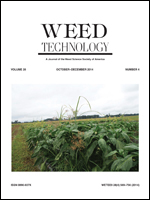Initial corn (IC) in a replant situation, which is surviving corn from the initial planting, as well as volunteer corn from the previous season, is a competitive weed, but little is known regarding the effect of IC density on grain yield of desirable replant corn (RC). Field trials were established in central and northeast Missouri during 2008 to 2010 to determine the impact of IC on the leaf chlorophyll, stalk diameter, and grain yield of RC. Glyphosate-resistant RC was planted in 76-cm rows, with hybrid glyphosate-resistant IC established for season-long competition between rows at densities of 0 to 8 plants m−2. At vegetative growth stages with six and eight leaf collars and at tasseling (V6, V8, VT), RC leaf nitrogen levels were reduced by 5 to 30% in the presence of IC at densities of one to eight plants m−2 compared with control plants lacking competition. Stalk diameters of RC at the VT growth stage were reduced from 8 to 30% by IC as densities increased from 0.5 to 8 plants m−2. Grain yield of row corn was reduced by IC, with yield losses ranging from 7 to 81%. Growth rate and biomass accumulation of hybrid and volunteer corn from V2 to VT were compared in the greenhouse to determine if competitive potential was similar. The second filial generation (F2) of corn from hybrid (DKC ‘63-42′) corn was collected from a field in central Missouri and southeastern Nebraska. There were no statistical differences found in growth rate or biomass accumulation between hybrid and F2 corn up to VT, although F2 plant biomass was numerically (up to 41%) lower at numerous growth stages. Hybrid corn is likely to be equally or more competitive with RC than volunteer corn. This research documents that in areas where IC remains among replanted corn, the IC has a negative impact at all densities evaluated.
Nomenclature: Glyphosate; corn, Zea mays L.
En una situación de resiembra, el maíz inicial (IC) el cual es el maíz sobreviviente de la siembra inicial, al igual que el maíz voluntario de la temporada anterior, son malezas competitivas, pero se conoce poco acerca del efecto de la densidad de IC en el rendimiento de grano del maíz de resiembra (RC). Se establecieron experimentos de campo en el centro y noreste de Missouri, desde 2008 a 2010, para determinar el impacto de IC en chlorophyll foliar, diámetro de tallo, y rendimiento de grano de RC. RC resistente a glyphosate fue sembrado en hileras espaciadas a 76 cm, con IC híbrido resistente a glyphosate establecido para obtener competencia durante toda la temporada de crecimiento entre las hileras a densidades de 0 a 8 plantas m−2. En los estados vegetativos de desarrollo con seis y ocho nudos foliares y en la formación de la panoja (V6, V8, VT), los niveles foliares de nitrógeno en RC se redujeron entre 5 y 30% en la presencia de IC a densidades de una a ocho plantas m−2, al compararse con plantas testigo sin competencia. El diámetro de los tallos de RC en el estado VT se redujo entre 8 y 30% al aumentar las densidad de IC de 0.5 a 8 plantas m−1. El rendimiento de grano del maíz fue reducido por el IC, con pérdidas de entre 7 y 81%. La tasa de crecimiento y la acumulación de biomasa del maíz híbrido y voluntario desde V2 a VT se comparó en el invernadero para determinar si el potencial competitivo fue similar. La segunda generación filial (F2) del maíz híbrido (DKC ‘63-42’) fue colectada de un campo de maíz en el centro de Missouri y en sureste de Nebraska. No hubo diferencias estadísticas en tasa de crecimiento o acumulación de biomasa entre híbridos y F2 de maíz hasta VT, aunque la biomasa por planta de F2 fue numéricamente más baja (hasta 41%) en varios estados de desarrollo. Es probable que el maíz híbrido sea igual o más competitivo con RC que el





